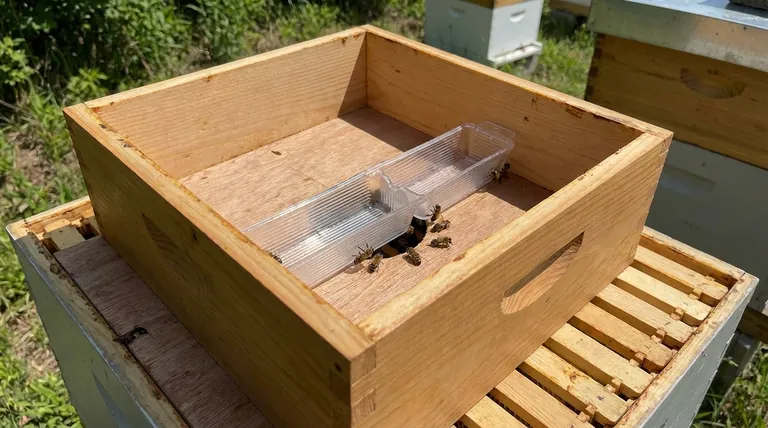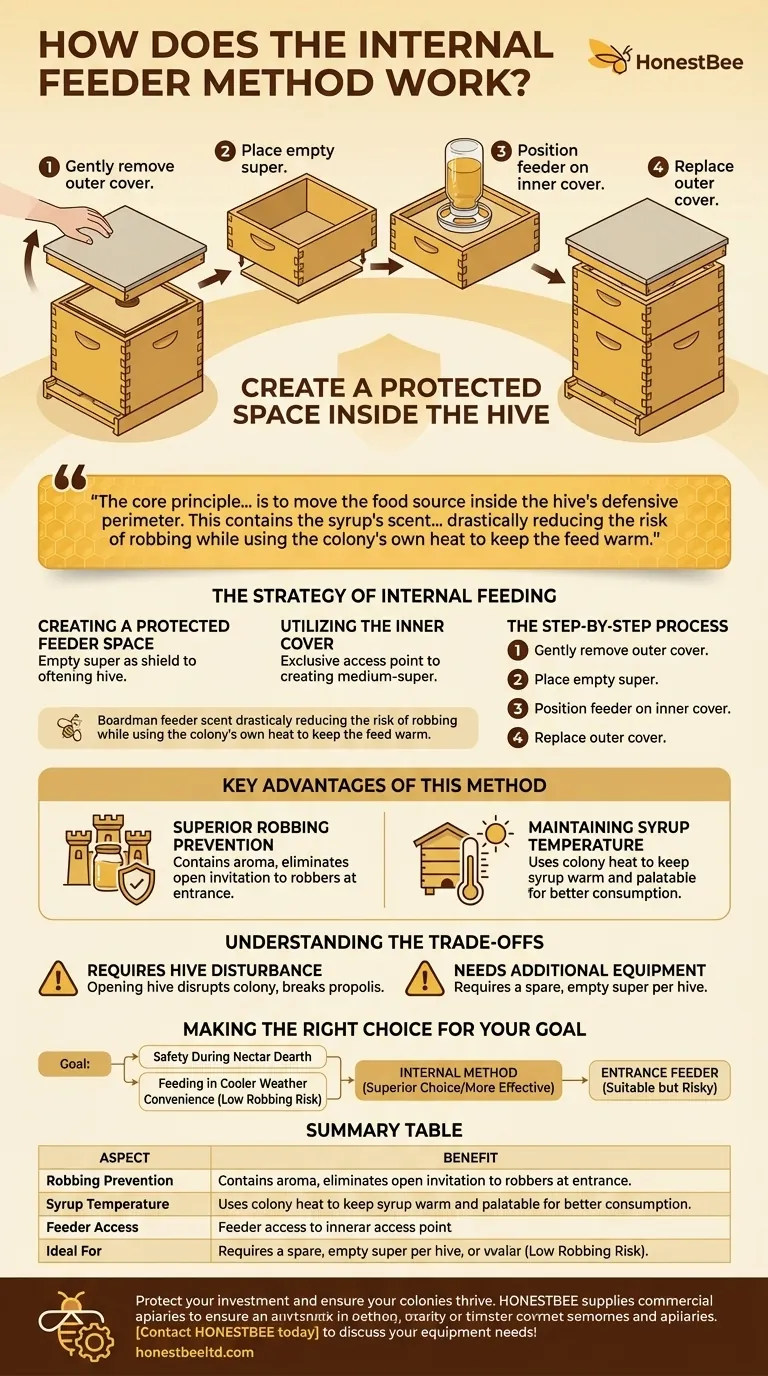To use the internal feeder method, you create a protected space on top of the hive. After removing the outer cover, place an empty super (a hive box without frames) directly onto the inner cover. The feeder, typically a Boardman feeder with a jar of syrup, is then placed inside this empty super, positioned over the hole in the inner cover, before the outer cover is replaced.
The core principle of the internal feeder method is to move the food source inside the hive's defensive perimeter. This contains the syrup's scent and shields it from outsiders, drastically reducing the risk of robbing while using the colony's own heat to keep the feed warm.

The Strategy of Internal Feeding
Placing a feeder inside the hive is a deliberate choice to enhance colony security and efficiency. It leverages the existing structure of the hive to create a private dining area for your bees, accessible only to them.
Creating a Protected Feeder Space
The empty super you place on the hive doesn't store honey; its sole function is to act as a protective shroud. This simple addition creates an enclosed space that shields the feeder from weather and, most importantly, from other bees in the apiary.
Utilizing the Inner Cover
The inner cover is the key to this setup. Its central hole, normally used for ventilation or as an upper entrance, becomes the exclusive access point for your bees to reach the syrup. They can travel up from the brood chamber directly to the feeder without ever leaving the hive.
The Step-by-Step Process
- Gently remove the outer telescoping cover of your hive.
- Place a medium super, with all frames removed, directly on top of the existing inner cover.
- Position your filled Boardman feeder (or a similar style) on the inner cover, ensuring the bees can access the syrup through the central hole.
- Carefully replace the outer cover on top of the empty super.
Key Advantages of This Method
Choosing to feed internally provides two significant benefits that directly impact the health and safety of your colony, especially when it's vulnerable.
Superior Robbing Prevention
Robbing is a major threat where stronger colonies steal resources from weaker ones, often resulting in the collapse of the robbed hive. Entrance feeders place the food source at the front door, broadcasting its scent and inviting chaos. By moving the feeder inside, you contain the aroma and eliminate the open invitation for robbers.
Maintaining Syrup Temperature
Bees are more likely to consume syrup that is warm. An internal feeder uses the natural heat generated by the bee cluster to keep the syrup at a more palatable temperature. This is particularly advantageous during the cooler temperatures of spring or fall when bees need the energy most but might ignore cold feed.
Understanding the Trade-offs
While effective, the internal method is not without its drawbacks. Objectively weighing the pros and cons is essential for proper hive management.
Requires Hive Disturbance
The primary downside is that you must open the hive to monitor and refill the feeder. Unlike an external entrance feeder that can be checked at a glance, this method involves removing the outer and inner covers, which disrupts the colony and breaks the propolis seal.
Needs Additional Equipment
This method requires a spare, empty super for every hive you intend to feed. For beekeepers with limited equipment, this can be a significant constraint.
Making the Right Choice for Your Goal
Selecting a feeding method depends entirely on the current conditions of your apiary and the specific needs of your colony.
- If your primary focus is safety during a nectar dearth: The internal method is the superior choice to prevent robbing and protect a vulnerable colony.
- If your primary focus is feeding in cooler weather: The internal method's ability to keep syrup warm makes it far more effective than an external feeder.
- If your primary focus is convenience and minimal disturbance: An entrance feeder may be suitable, but only when the risk of robbing is extremely low.
Ultimately, understanding how to feed your bees internally is a crucial skill for protecting your colony when it is most vulnerable.
Summary Table:
| Aspect | Benefit |
|---|---|
| Robbing Prevention | Contains syrup scent inside the hive's defenses. |
| Syrup Temperature | Uses colony's heat to keep feed warm and palatable. |
| Feeder Access | Bees access food via the inner cover hole without leaving the hive. |
| Ideal For | Nectar dearths and cooler spring/fall weather. |
Protect your investment and ensure your colonies thrive. The internal feeder method is essential for modern apiary management. HONESTBEE supplies commercial apiaries and beekeeping equipment distributors with the durable, high-quality supplies needed to implement this and other best practices efficiently. Let our wholesale-focused operations support your success. Contact HONESTBEE today to discuss your equipment needs!
Visual Guide

Related Products
- In-Hive Dual Compartment Frame Bee Feeder for Targeted Colony Nutrition
- Boardman Entrance Bee Feeder Durable Galvanized Steel and Wood Construction for Beekeeping
- Professional Hive Front Entrance Bee Feeder
- HONESTBEE Professional Entrance Bee Feeder Hive Nutrition Solution
- Classic Boardman Entrance Bee Feeder Hive Front Feeding Solution
People Also Ask
- What are division board feeders? Essential Tools for Safe and Effective In-Hive Feeding
- What is a frame feeder? A High-Capacity, Secure In-Hive Feeding Solution
- When is sugar syrup typically fed to bees? A Guide to Strategic Feeding for Strong Hives
- What are frame feeders, and what are their advantages? Essential for Cold Weather & Efficient Feeding
- Are frame feeders good? Maximize Your Hive's Health with the Right Feeding Strategy



















